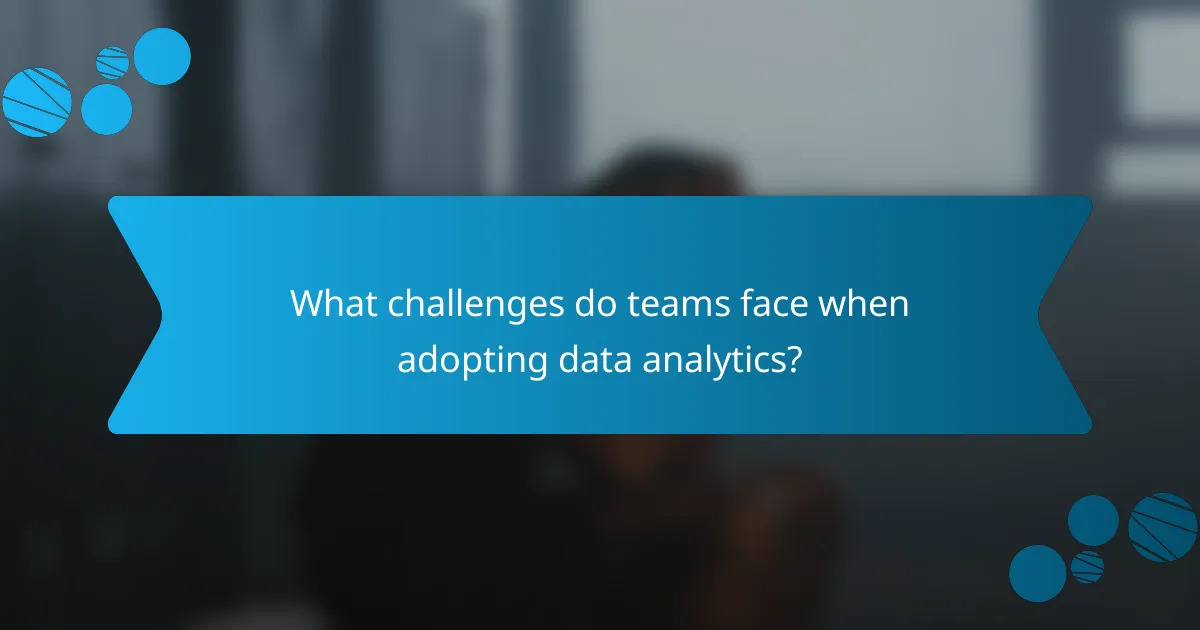Data analytics enhances sports performance by providing actionable insights that improve training and game strategies. This article explores advanced tools like wearable technology, applications in injury prevention, and performance analysis. It also addresses challenges teams face in adopting analytics and highlights trends shaping the future of sports performance. Understanding these aspects is essential for athletes and coaches seeking a competitive edge.

How does data analytics enhance sports performance?
Data analytics significantly enhances sports performance by providing actionable insights through data collection and analysis. Coaches and athletes utilize performance metrics to identify strengths and weaknesses, optimize training regimens, and improve game strategies.
Advanced tools like wearable technology track player movements and physiological responses, offering real-time feedback. For example, heart rate monitors and GPS devices help in assessing player endurance and recovery.
Moreover, data analytics enables injury prediction and prevention by analyzing historical injury data and biomechanical patterns. This proactive approach can extend athletes’ careers and enhance team performance.
Overall, the integration of data analytics in sports leads to informed decision-making, tailored training programs, and a competitive edge in performance outcomes.
What are the key data analytics tools used in sports?
Key data analytics tools in sports include software and platforms that analyze performance metrics, player statistics, and game strategies. Popular tools are Tableau, SAS, and R, each providing unique insights for teams. Additionally, tools like Sportscode and Catapult focus on video analysis and wearable technology, enhancing player performance tracking. These tools leverage data to improve decision-making and strategy development in sports.
Which metrics are most valuable for athlete performance analysis?
Key metrics for athlete performance analysis include speed, endurance, strength, agility, and recovery time. These metrics provide insights into an athlete’s physical capabilities and overall performance.
Speed is often measured in meters per second during sprints. Endurance can be assessed through VO2 max, indicating aerobic capacity. Strength is typically evaluated via weight lifted or resistance levels. Agility is measured using time taken in shuttle runs or cone drills. Recovery time reflects how quickly an athlete returns to baseline performance after exertion.
These metrics form a comprehensive framework for understanding and enhancing athletic performance.
How do teams implement data analytics strategies effectively?
Teams implement data analytics strategies effectively by integrating technology, fostering collaboration, and focusing on actionable insights. Utilizing advanced tools like performance tracking software and data visualization platforms enhances decision-making. Regular training and clear communication among team members ensure everyone understands the data’s relevance. Establishing specific goals allows teams to measure success and adjust strategies accordingly.
![]()
What insights can be derived from player tracking data?
Player tracking data provides insights into athlete performance, team dynamics, and strategic decision-making. It reveals metrics such as speed, distance covered, and player positioning during games. Analyzing these metrics helps identify strengths and weaknesses, informing training and game strategies. For instance, tracking data can highlight a player’s endurance levels, enabling tailored conditioning programs. Additionally, it fosters improved teamwork by analyzing player interactions and movements on the field.
How does wearables technology contribute to performance insights?
Wearable technology significantly enhances performance insights by collecting real-time data on athletes’ metrics. These devices track heart rate, movement, and other vital statistics, enabling coaches to make informed decisions. By analyzing this data, teams can tailor training programs to individual needs, optimizing performance. Additionally, wearables provide unique insights into recovery patterns, helping prevent injuries and enhance overall athlete well-being.
What role does video analysis play in performance evaluation?
Video analysis is crucial in performance evaluation as it provides detailed insights into athlete movements and strategies. This technology allows coaches and athletes to assess performance metrics, identify strengths and weaknesses, and make data-driven decisions for improvement. By analyzing video footage, teams can refine techniques, enhance tactical understanding, and optimize training regimens. Moreover, video analysis can reveal unique attributes of individual athletes, contributing to personalized training plans that maximize performance potential.

Which applications of data analytics are most impactful in sports?
Data analytics significantly enhances sports performance through various impactful applications. These include performance analysis, injury prevention, fan engagement, and strategic decision-making.
Performance analysis utilizes data to evaluate athletes’ strengths and weaknesses, improving training regimens. Injury prevention relies on analytics to monitor player health, reducing the risk of injuries. Fan engagement employs data to personalize experiences and drive ticket sales. Strategic decision-making leverages insights for game tactics and player acquisitions.
Each application demonstrates how data analytics transforms sports, optimizing performance and enhancing overall engagement.
How can data analytics inform injury prevention strategies?
Data analytics can significantly enhance injury prevention strategies by identifying patterns and risk factors. By analyzing player data, coaches can pinpoint high-risk movements and adjust training regimens accordingly.
Injury prediction models utilize historical data, biomechanics, and workload metrics to forecast potential injuries. For instance, tracking fatigue levels and injury history can inform individualized training plans, reducing injury rates.
Moreover, real-time analytics during practice and games provide immediate feedback, allowing for quick adjustments. This proactive approach fosters a culture of safety and enhances overall player performance.
Ultimately, leveraging data analytics leads to informed decisions that minimize injuries and promote athlete longevity.
What are the implications of data analytics on training regimens?
Data analytics significantly enhances training regimens by providing actionable insights. Coaches and athletes can track performance metrics, identify strengths and weaknesses, and tailor training programs accordingly.
Utilizing tools like wearable technology and software analytics, teams can analyze data in real-time. This leads to optimized training loads, injury prevention strategies, and improved recovery protocols.
For example, analyzing heart rate variability can help determine an athlete’s readiness for training, ensuring sessions are effective and safe. As a result, data-driven decisions foster better performance outcomes and athlete longevity.
Incorporating data analytics into training regimens represents a shift towards a more scientific approach in sports performance, ultimately benefiting athletes’ development and success.
How does data-driven decision-making affect game strategy?
Data-driven decision-making significantly enhances game strategy by providing actionable insights. Teams utilize data analytics to assess player performance, optimize training regimens, and develop game plans tailored to opponents’ weaknesses.
Advanced tools like video analysis and performance metrics allow coaches to make informed adjustments during games. For example, real-time data can reveal when a player is fatigued, prompting timely substitutions.
Additionally, predictive analytics forecasts outcomes based on historical data, helping teams strategize effectively against various scenarios. This approach fosters a competitive edge by leveraging precise, data-backed strategies.
Ultimately, the integration of data analytics transforms traditional game strategies into dynamic, evidence-based approaches that adapt to the evolving nature of sports performance.

What challenges do teams face when adopting data analytics?
Teams face several challenges when adopting data analytics in sports performance. Key obstacles include a lack of technical expertise, insufficient data quality, and resistance to change within the organization.
Technical expertise is crucial for effectively interpreting analytics. Many teams struggle to find skilled personnel who can leverage data tools. Additionally, data quality issues can arise from inconsistent data collection methods, leading to unreliable insights.
Resistance to change often stems from traditional practices in sports. Teams may hesitate to integrate analytics into their strategies, fearing disruption to established routines.
Lastly, securing adequate resources for analytics initiatives can be a challenge. Budget constraints may limit investment in necessary tools and training, hindering overall effectiveness.
How can data privacy concerns be addressed in sports analytics?
Data privacy concerns in sports analytics can be addressed through robust data governance frameworks. Implementing strict access controls ensures that only authorized personnel can view sensitive information.
Regular audits and compliance checks help maintain adherence to privacy regulations like GDPR. Additionally, anonymizing data reduces risks while still enabling valuable insights. Educating stakeholders about data privacy fosters a culture of responsibility and trust.
What are the common pitfalls in interpreting sports data?
Common pitfalls in interpreting sports data include over-reliance on statistics, ignoring context, and misinterpreting correlations. These mistakes can lead to flawed conclusions about player performance or team strategy.
Over-reliance on statistics can obscure the qualitative aspects of performance, such as teamwork and mental resilience. Ignoring context, such as game conditions or player injuries, can skew interpretations. Misinterpreting correlations, like assuming a player’s scoring average directly correlates with game outcomes, can lead to erroneous assessments.
Additionally, failing to account for sample size can result in misleading insights. Small data sets may not represent broader trends, leading to overgeneralizations. Understanding these pitfalls is crucial for accurate analysis in sports data analytics.

How do different sports leverage data analytics uniquely?
Different sports utilize data analytics to enhance performance by focusing on unique metrics relevant to their specific needs. For instance, basketball emphasizes player efficiency ratings and shot analytics, while football analyzes player movements and game strategies.
In baseball, teams leverage sabermetrics to evaluate player performance through statistics like on-base percentage and slugging percentage. Soccer employs tracking data to assess player positioning and team dynamics during matches.
Additionally, sports like cycling and athletics use data analytics to optimize training regimens by monitoring physiological metrics such as heart rate and power output. These tailored approaches ensure that each sport maximizes its potential through data-driven insights.
What distinguishes data analytics practices in team sports versus individual sports?
Data analytics practices in team sports differ significantly from those in individual sports due to the complexity of data interactions. Team sports focus on collective performance metrics, player synergy, and strategic formations. Individual sports emphasize personal performance, technique analysis, and psychological factors.
Team sports utilize advanced tracking technologies to analyze player movements and interactions, allowing coaches to optimize team strategies. In contrast, individual sports often rely on wearable devices that measure personal metrics such as heart rate and speed.
Moreover, team sports benefit from collaborative data analysis, facilitating communication among players and coaches. Individual sports typically involve solo analysis, where athletes assess their performance independently.
Finally, the data interpretation in team sports often considers the dynamics of multiple players, while individual sports focus on singular performance outcomes.
Which sports are leading the way in data analytics innovation?
Data analytics is transforming sports performance, with basketball, football, and baseball leading in innovation. These sports utilize advanced metrics and real-time data to enhance player performance and strategy. Basketball teams analyze shooting efficiency and player movement, while football focuses on player tracking and injury prevention. Baseball employs sabermetrics for player evaluation and game strategy.

What future trends in data analytics should sports professionals watch?
Sports professionals should watch trends in artificial intelligence, wearable technology, and predictive analytics. These advancements enhance performance analysis, injury prevention, and game strategy.
Artificial intelligence tools are increasingly used to analyze player data, providing insights that lead to better training programs. Wearable technology, such as smart sensors and GPS trackers, allows real-time performance monitoring, helping athletes optimize their training regimens. Predictive analytics can forecast player performance and injury risks, enabling teams to make informed decisions.
The integration of these technologies shapes the future of sports performance analytics, offering competitive advantages. As a result, staying updated on these trends is crucial for sports professionals aiming to enhance their strategies and outcomes.
How might artificial intelligence transform sports analytics?
Artificial intelligence is set to revolutionize sports analytics by enhancing data interpretation and decision-making. AI algorithms can process vast amounts of performance data, providing insights that were previously unattainable. These insights include predictive analytics for player performance, injury prevention, and game strategy optimization. As a result, teams can make data-driven decisions that improve overall performance and competitive advantage. The integration of machine learning models allows for real-time analysis, enabling coaches to adapt strategies during games based on player and opponent behavior.
What emerging technologies are shaping the future of sports performance analysis?
Data analytics is transforming sports performance analysis through innovative technologies. Wearable devices provide real-time data on athlete biometrics, while video analysis software enhances technique evaluation. Machine learning algorithms offer predictive insights for performance optimization. Additionally, cloud computing facilitates data storage and accessibility for teams. These technologies collectively improve training efficiency and competitive strategies.
What best practices should teams follow for effective data utilization?
Teams should adopt a structured approach to data utilization for effective sports performance analytics. Key best practices include defining clear objectives, ensuring data quality, using appropriate analytical tools, and fostering collaboration among team members.
1. Define clear objectives: Establish specific goals for data analysis that align with team performance metrics.
2. Ensure data quality: Regularly validate data sources and maintain accuracy to enhance insights.
3. Use appropriate analytical tools: Select tools that fit the team’s needs, such as performance tracking software or statistical analysis programs.
4. Foster collaboration: Encourage communication among coaches, analysts, and athletes to integrate insights into training and strategy.
These practices enhance decision-making and optimize player performance through data-driven insights.